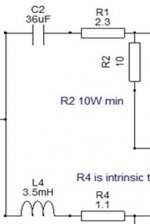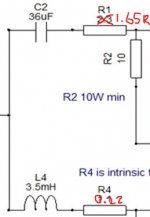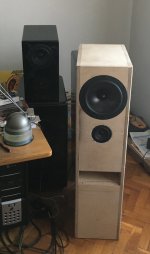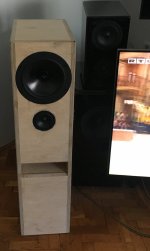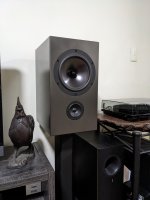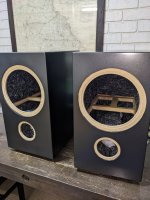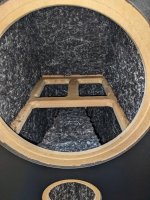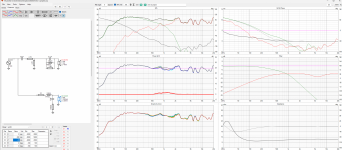Measured it accurately using verniers, it's really 2mm square. We use it on windows in Oz & it does keep mosquitoes out.
Like the idea of fine tuning with the aquarium foam ! Is impedance measurement at amp side of crossover OK ?
BTW, I wound my own 3.5mH coils with 1.6mm diam wire over ferrite slugs. DCR came out at 0.22R. I've dropped R1 to 1.65R to compensate. Does that sound about right to you ?
Like the idea of fine tuning with the aquarium foam ! Is impedance measurement at amp side of crossover OK ?
BTW, I wound my own 3.5mH coils with 1.6mm diam wire over ferrite slugs. DCR came out at 0.22R. I've dropped R1 to 1.65R to compensate. Does that sound about right to you ?
Attachments
It’s really up to your ears. If it sounds too bright increase value of R1, not enough highs then decrease. I think you are saying since bass is going to be a bit higher, you are increasing treble. That’s fine.
For the impedance measuring at the amp in (with XO in place) is correct way to do it.
For the impedance measuring at the amp in (with XO in place) is correct way to do it.
Hey xrk971, another TL is made, I am showing my work, not finished with paint, too excited to hear the sound.
I will do some modification on crossover of the 10F8424 because I like a little brighter sound.
My internal resistance of the bass crossover inductance is 0,6ohm, maybe that is the reason why bass is a little bit higher then full range speaker.
My L pad resistance is 4R7 and 4R7. Maybe some suggestion for L pad, because for now I am not able to measure with ARTA (my setup is not functional).
I am using LM3886 amplifiers, I have 3 amps, one zero zone (current feedback) and two with parallel LM3886 with 68W/8ohm.
I have now chance to listen on 80W class A amp made by AM Audio Reference S2, but for now I am on Gain Clone models.
Sound is powerful, but I like a little bit higher midrange and treble.
I will do some modification on crossover of the 10F8424 because I like a little brighter sound.
My internal resistance of the bass crossover inductance is 0,6ohm, maybe that is the reason why bass is a little bit higher then full range speaker.
My L pad resistance is 4R7 and 4R7. Maybe some suggestion for L pad, because for now I am not able to measure with ARTA (my setup is not functional).
I am using LM3886 amplifiers, I have 3 amps, one zero zone (current feedback) and two with parallel LM3886 with 68W/8ohm.
I have now chance to listen on 80W class A amp made by AM Audio Reference S2, but for now I am on Gain Clone models.
Sound is powerful, but I like a little bit higher midrange and treble.
Attachments
Just finished up this pair of 10F/RS225 Fast in metallic charcoal and initial impressions are very positive. Will let them run in for a week or two and take some measurements.
X, can't thank you enough for making this available. I can definitely see the TL version in my future when space becomes available.
Cheers.
Dutch
X, can't thank you enough for making this available. I can definitely see the TL version in my future when space becomes available.
Cheers.
Dutch
Attachments
Wow! Beautiful cabinets there, Dutch!
Hope you enjoy them. The bass may improve a bit with break in.

Hope you enjoy them. The bass may improve a bit with break in.

Hi everyone,
I have a pair of 3fe22 (16 ohms version) and sb23nrsx45-8 and interested in this design.
Could I ask for an adjusted crossover schematic to implement it with this drivers?
I have a pair of 3fe22 (16 ohms version) and sb23nrsx45-8 and interested in this design.
Could I ask for an adjusted crossover schematic to implement it with this drivers?
I haven’t made a crossover for this combo of drivers and actually never seriously tried since the SB23 doesn’t have the same wide bandwidth as the RS225-8. In all of these designs, the constant has been the RS225-8. Move from that and it’s a totally new speaker. The 3FE22-16 is a nice sounding driver - very smooth and nice top end. But being 16ohms also totally changes everything.
If you want it to try the base crossover for the 10F/RS225-8 and modify it based on fact that full range is 16ohms, you can try cutting the large cap value in half to circa 33uF for C2 and pad it a little more since it’s 91dB sensitive. Try 3.3R for R1 and 10R for R2. For the woofer, leave it as is or drop value of inductor a bit. It might look similar to the crossover for the B80/RS225.

The only way to know for sure is to have a microphone an make some measurements. Use Wago clip connectors and play around with resistor values and the cap value. In the meantime use your ears and listen. Adjust the padding resistors to get the right balance. The capacitor and inductors are harder to hear the effects but they can be significant with regard to causing dips which are harder for us to detect than peaks.
If you want it to try the base crossover for the 10F/RS225-8 and modify it based on fact that full range is 16ohms, you can try cutting the large cap value in half to circa 33uF for C2 and pad it a little more since it’s 91dB sensitive. Try 3.3R for R1 and 10R for R2. For the woofer, leave it as is or drop value of inductor a bit. It might look similar to the crossover for the B80/RS225.
The only way to know for sure is to have a microphone an make some measurements. Use Wago clip connectors and play around with resistor values and the cap value. In the meantime use your ears and listen. Adjust the padding resistors to get the right balance. The capacitor and inductors are harder to hear the effects but they can be significant with regard to causing dips which are harder for us to detect than peaks.
Last edited:
Faital lists all versions of 3fe22 as 91db, which I find hard to believe. They all seem to share the same motor...
Is it possible that only the 4 ohms version is 91db, 8ohms is ~88db and 16ohms~85db?
Also, the B80 is 8 ohms and 85db.
Is it possible if 3fe22-16 is also 85db, then C2 would need be about half of 36uF?
Unfortunately I dont have any measuring equipment...
Is it possible that only the 4 ohms version is 91db, 8ohms is ~88db and 16ohms~85db?
Also, the B80 is 8 ohms and 85db.
Is it possible if 3fe22-16 is also 85db, then C2 would need be about half of 36uF?
Unfortunately I dont have any measuring equipment...
It might be based on 1watt and 2.83vrms into 8ohms.
You should consider getting a mic for this hobby. $60.
https://www.parts-express.com/Dayton-Audio-EMM-6-Electret-Measurement-Microphone-390-801
Or spend $50 on a pair of 8ohm 3FE25-8’s.
You should consider getting a mic for this hobby. $60.
https://www.parts-express.com/Dayton-Audio-EMM-6-Electret-Measurement-Microphone-390-801
Or spend $50 on a pair of 8ohm 3FE25-8’s.
When I got these speaker boxes and was gifted with the woofers to put in them, I was excited to finally hear a design vetted by the forum. I was not expecting to be so critical once I heard them. If the original design sounded great, then the TC9FD is probably not like the 10f at all.
In my case the treble was way too soft, the midbass was absent and the mids were overblown and marble-mouthed. The reason is kind of convoluted. The TC9FD has less sensitivity than the 10f but has a descending response from the bass whereas the 10f has a well damped rising bass response. In the case of the TC9FD this means the drivers cancel in the midbass and we lose it. When we raise the level of the tweeter to bring the highs to the level of the 10f, the cancellation gets worse. Both these issues together mean that ultimately you end up with boosted mids around 1KHz if you try and reach a compromise. This is also where the natural baffle step hump is... So the crossover really needed redone.
I suspect that the original suffers from this issue just to a lesser degree. I'm also extremely curious whether my crossover would change if I had the baffle with the offset tweeter...
I must have done hundreds of measurements, maybe even thousands by now. And in between those bursts of measurements, I was listening. It's not as if I am just trying to create a flat response or get a perfect impulse response. That is a good target or starting point, but despite my best efforts I have to allow some departures from what is hypothetically accurate, in order to make a sound that me and my weary test subjects (family) actually want to listen to, and resembles what instruments might actually sound like.
In this case I think it may have a lot to do with the ringing of the tweeter at 3.5KHz in combination with the diffraction from 3 baffle edges at the same distance. With my current preferred crossover this region ended up suppressed, which suggests that unevenly dispersive ringing is far worse than a deviation from a straight line in the step response.
As much as I like the idea of a good step response and time alignment, I only view that as a starting point. If the result doesn't sound good, adjustments have to be made. To come up with a good step response chart and then say I was finished would be ignoring a great deal of my own experience listening to my modifications.
But ultimately I don't have a bucket full of inductors to test with, and my design may be as much a result of my flawed listening environment as it is genuine problem solving. It would be better at this point for someone to replicate my work and add their observations, because it's not obvious whether I'm improving it at this point or just changing the flavor. And actually I need a long break. I've actually spent many, many hours on this. Here is where I'm at:
View attachment 1075186
All the extra tweeter components were unnecessary as far as I can tell, and don't seem to be needed for the TC9FD. The treble was rolled off a bit in the 10f crossover which was not an advantage here where the diffraction means we need to be off-axis and still have good treble response.
Changing the value of R5 has a very interesting effect on the sound...
I don't know what this crossover would do for the 10f, but I would use the woofer portion of this crossover with either tweeter. I think the step response could likely be improved. The step response of this crossover is pretty good even though it's not the best I achieved, but it sounds so much better than the version with the best step response.
The imaging is unreal at times. All of the music sounds better, it is smooth yet detailed, all the instruments can be heard when they were intended to be heard and not climbing over each other. The imaging is incredibly solid, not exaggerated at all, just very life-like, as if something is really there. Especially with nature sounds.
Can I throw in a ScanSpeak Revelator 22W/8857T-00 8" Woofer?
https://www.madisoundspeakerstore.c...evelator-22w/8857t-00-8-woofer-aluminum-cone/
https://www.parts-express.com/Dayton-Audio-RS225-8-8-Reference-Woofer-295-356
The specs look pretty close except for the Le.
I need the 22W to be louder than the T9C.
There's a speaker manufacture that makes a 10F and 22W speaker, but now I can't find the link anymore.
Was curious to see it again, but I mainly just need to design the cross-over.
8" and 3-4" drivers is all I need. I'm not really into highs/tweeters.
And if the highs disappear off-axis, that's a plus, we don't have to hear them if we're walking around.
Last edited:
That SS 22W is a nice driver. But it has a natural falloff at 1kHz. If that is coupled with a first order electrical it will result in a second order electro-acoustic falloff. That won’t work for a 1st order crossover at 900Hz. This driver is ideally suited for a more traditional 2nd order or 4th order crossover.
RS225-8:

22W:

RS225-8:
22W:
Last edited:
Interesting idea. Initially I would not use any other woofer with my crossover because it is tuned specifially for the RS225, but this driver may fit. However the response will be worse just because the driver has a worse response and the crossover was not tuned for it.
The Scan speak woofer has better directivity behavior around 1KHz which does make me curious if it could sound better on vocals.
It would be an interesting test, but I wouldn't swap them freely unless I was also comfortable with redoing the crossover.
The Scan speak woofer has better directivity behavior around 1KHz which does make me curious if it could sound better on vocals.
It would be an interesting test, but I wouldn't swap them freely unless I was also comfortable with redoing the crossover.
Hi.
I made it 🙂
after a long fight with XO I change several times Cap to Miflex Cu finally i bought 4 sets different Fullrange 3.5-4" speakers. I ve tested:
Fountek FR88EX
Tang Band W3-1364SA
Dynavox LY302F 3.5"
and finally bought a cheap aima 4" and now it sounds delish.
So don't stay just with one project, it's always is something to improve sound quality 🙂
The next step will make closed monitor speakers with 2 active subwoofers based on peerless SLS 10" and put them in the proper place in the living room to make better bass control ( I've got a big problem with several waves ( 50 and 100Hz) but if I not use central bass and move the location of subs it will help to fix that room acoustic issue.
I made it 🙂
after a long fight with XO I change several times Cap to Miflex Cu finally i bought 4 sets different Fullrange 3.5-4" speakers. I ve tested:
Fountek FR88EX
Tang Band W3-1364SA
Dynavox LY302F 3.5"
and finally bought a cheap aima 4" and now it sounds delish.
So don't stay just with one project, it's always is something to improve sound quality 🙂
The next step will make closed monitor speakers with 2 active subwoofers based on peerless SLS 10" and put them in the proper place in the living room to make better bass control ( I've got a big problem with several waves ( 50 and 100Hz) but if I not use central bass and move the location of subs it will help to fix that room acoustic issue.
Attachments
-
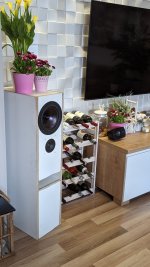 PXL_20220330_155542407.PORTRAIT.jpg343.3 KB · Views: 161
PXL_20220330_155542407.PORTRAIT.jpg343.3 KB · Views: 161 -
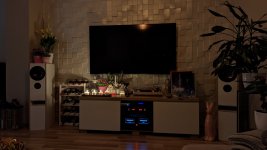 PXL_20220330_175507500.NIGHT.jpg209.6 KB · Views: 160
PXL_20220330_175507500.NIGHT.jpg209.6 KB · Views: 160 -
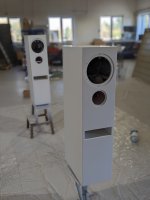 PXL_20221020_130923206.PORTRAIT.jpg166.5 KB · Views: 155
PXL_20221020_130923206.PORTRAIT.jpg166.5 KB · Views: 155 -
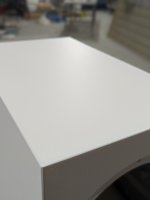 PXL_20221020_161007743.PORTRAIT.jpg111.4 KB · Views: 154
PXL_20221020_161007743.PORTRAIT.jpg111.4 KB · Views: 154 -
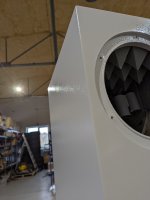 PXL_20221021_102027611.jpg228.9 KB · Views: 164
PXL_20221021_102027611.jpg228.9 KB · Views: 164 -
 PXL_20221103_212710718.PORTRAIT.jpg378.3 KB · Views: 177
PXL_20221103_212710718.PORTRAIT.jpg378.3 KB · Views: 177
Last edited:
Hi rxr2, congratulations on a super job! They look wonderful. Nice that you tried to many different fullrange drivers. Can you please share the model number of the driver you settled on and any changes to the crossover?

Love this



Love this
I think he is referring to this?
https://www.dhgate.com/product/aiyima-4-inch-full-range-speaker-unit-4-8/761548318.html
https://www.dhgate.com/product/aiyima-4-inch-full-range-speaker-unit-4-8/761548318.html
Yes, you're right.I think he is referring to this?
https://www.dhgate.com/product/aiyima-4-inch-full-range-speaker-unit-4-8/761548318.html
it was totally blind buy. I just try to buy PCB with TPA3255 for my test and I figure out that one seller got those speakers.
I add a notch filter because they got some not linear characteristics in upper frequency and they do not reach 20khz but anyway they are worth some more investigation for future application.
about sound: Much more brittle and more intense in vocals, the sound is cleared and more open like the room where you listen gets bigger.
Second place got Fountek FR88EX. then scanspeak.
not this one. that is the white version.I think this is it https://www.aliexpress.us/item/2255800852923903.html
my is yellow with magnet shield
https://www.aliexpress.com/item/100...00030514092694!sea&curPageLogUid=iKW5kq48IbY0
Last edited:
- Home
- Loudspeakers
- Full Range
- 10F/8424 & RS225-8 FAST / WAW Ref Monitor
